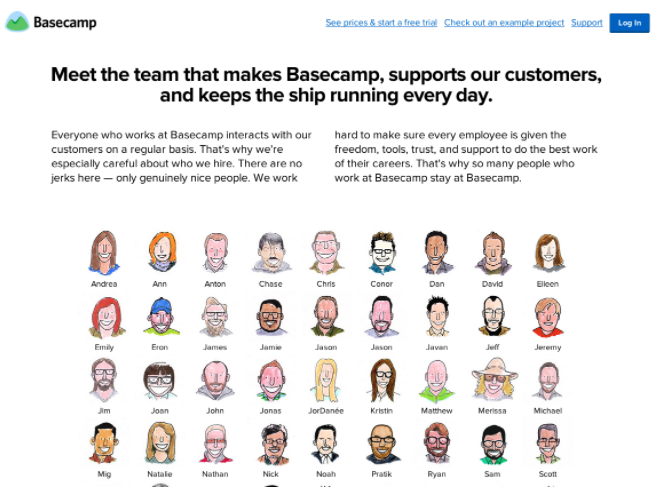Dr. Robert B. Cialdini wrote his book ‘Influence: The Psychology of Persuasion’ in 1984. Since then his book became well spread and popular among marketers. And even now, it’s still super relevant for digital marketers. Robert Cialdini identified six principles how to persuade people to say yes (or convert). Haven’t read the book (yet)? No problem, we’ve summarized his principles and how you can use these online.
#1: Reciprocity (Give something to get something in return)
The first persuasion principle is reciprocity. The primal instinct of people basically triggers a desire to to return favours and pay back our debts. Mainly we treat others as they treated us. Is someone nice to you? Your natural response probably is to be nice to him or her too. When a colleague buys you a coffee, you’ll probably buy a coffee for him the next time you walk past that nice coffee stand.
When you walk past a charity fundraiser in the street and they give you a free gift (like a key ring) you’ll feel probably more obligated to give them something back, for instance by signing up or donating to their cause. Cialdini found that people are actually more willing to say yes when offered a free gift by a charity fundraiser than when this is not offered.
How to use the reciprocity principle online?
Give your website visitors something of value to them for free. This can be free tools, free downloads, free trials, free downloads, free goodies; anything they will benefit from. They’ll be more likely to buy something from you. Another great example is sending a personalized voucher code with a discount when it’s your customer’s birthday. Or tweeting about this blogpost if you like it =).

Yes, at Catchi we’re using this principle too – by offering a free e-book.
#2 Commitment/consistency (People tend to stay consistent when they said yes before)
The principle of commitment and consistency formulated by Robert Cialdini is a great weapon to persuade visitors step-by-step to take the desired action. Once visitors are persuaded to take a small step, they are more willing to say “yes” to a next request. People want to show consistent behaviour.

Would you say yes to such a sign in your garden?
One of the best examples Cialdini used in his book was an experiment in a suburb of California. He went from door to door with an absurd request. He asked people if they wanted to place a huge sign with ‘Drive safely’ in their garden. Of course (almost) no one agreed with his request. But, in one street a strange thing happened– 76% of the people actually said yes to his request. Why did they say yes, while people in all the other streets said no? Well, one week earlier a volunteer came to their door with the request of placing a little sticker on their window with the same text on it. As it was such a small request a lot of people agreed to put the sticker on their window. When one week later the same person returned and asked for placing the huge sign in their garden, it was harder for these people to decline his request and so they said yes because they said yes before and wanted to be consistent. Once we’ve committed to something, we’re then more inclined to go through with it.
How to use the commitment and consistency principle online?
This principle is perfect to use for (long) online forms. Let visitors say yes to a small request and then to the next and the next. Online dating sites are using this principle for their signup form, by asking people a few personal questions and later on for their credit card details.

An example of the commitment and consistency principle.
#3 Social proof (When other people do it, it should be good)
The third principle ‘social proof ‘ is used a lot – probably because it’s a real conversion booster. Cialdini describes social proof as people doing what they see other people doing. When a particular eatery is always full of people, it’s more likely for us to give that establishment a try as well. Do you remember the last time you landed at the airport? You probably just followed the stream of people to the baggage handling.
Social psychology has done a lot of experiments that illustrate this unavoidable, human phenomenon. A classic example is this 1960’s elevator experiment. When a person enters an elevator, they are likely the look the same way as the majority in the elevator does. Here is funny video (2 min 31s) with footage of the experiment:
Social proof will be even more powerful if it’s not any random mass of people doing something, but people you know, respect and like – your friends for instance.Using social media widgets to show off the number of followers you have on Facebook, Twitter and Google+ is a great idea. But it can work the other way too – showing a very low number of likes and followers (worse yet – 0) is negative social proof (meaning nobody likes this stuff, and you shouldn’t be the only idiot either). Lots of eCommerce some sites have Like buttons on their product pages and typically have zero “likes”!
How to use the social proof principle online?
Basically show what other people are doing, recommending or thinking. This can be done in various ways online:
- Show numbers. ‘xx visitors bought this product today, ‘xx facebook likes’, ‘xx visitors are looking at this page at the moment’, ‘more than 1m books sold’.
- Display reviews and testimonials of actual customers (no fakes – people will notice a fake one)
- Display ratings
- People love lists. Use lists like ‘Most Popular products’, ‘Top sellers’ e.g.
A real killer site that uses social proof is booking.com. They are using the social proof (and the other six principles) a lot and very effectively.


Noticed all the social proof elements?
#4 Authority (People trust the ‘doctor in the white’ coat)
‘If he/they say(s) so, it should be good’. People are wired to obey figures of authority. This can be done by using the classic doctor in the white coat or by featuring a famous person. Remember those toothpaste commercials with a dentist recommending that specific toothpaste? Note: it doesn’t have to be a widely known person – it has to be an authority in the perception of the customer, such as an industry expert or a well-respected organisation. If you sell fitness products, use a prominent athlete to endorse them. Selling food? Team up with a well-known chef or a well-respected food magazine.
One classic example is the 1963’s Milgram experiment which you may be familiar with. It shows that more people are willing to go beyond their own limits when an authority says it’s OK to do it. Watch this video if you want to learn more about this classic experiment.
How to use the authority principle online?
- Display a known figure that recommends your products/services (in your audience’s perception)
- Display logos of clients you’ve worked with, awards you’ve won, quality marks,etc.
- Show logo of news newspapers/blogs that wrote about you (“Featured in”)

- Display security logos

- Using the authority and the social proof principle together by showing testimonials of well-known authorities to really boost conversions.
#5 Liking (The more you like someone, the more likely it is to be persuaded by him)
The fifth principle is the liking – when you like someone, the change is higher that he/she wil be able to persuade you.When you meet a new person and you have something in common (such as hair colour) you’ll subconsciously like that person sooner. How sympathetic is your brand / site? Do people like talking about you? Does your site have the click or x factor? People (visitors) are more likely to say yes when they like you. Your visitor feeling an instant click with your site can be achieved by aligned the site with them in some way, for instance it speaks their language or uses images that are appealing to them. Think of Richard Branson of Virgin with his airlines, phone services e.g. – millions of people like and feel connected with his brand.
How to use the liking principle online?
This can be done by showing who you are and what you stand for. Instead of using a boring “about us” page – show faces, show your story. Show your visitors who’s behind the brand / site / webshop which can help creating that “click”. Most often, especially for B2B and SaaS companies, the about us page is visited a lot so it’s a real opportunity to create that “like” factor.

#6 Scarcity (When a product is running out, you want it even more)
We’ve reached the last influence principle, scarcity. The bottom line of this principle is that products are becoming more attractive and valuable in the perception of people when their availability is limited – or when we stand to lose the opportunity to acquire them on favorable terms.
Scarcity is one of the most popular and most used principles used by companies to boost conversion. In our experience, scarcity can be a very powerful tool. However, be careful using this principle, asusing it in a fake way can actually harm conversions and your brand.For instance, downloadable e-books are sometimes offered with the mention that “we’ve almost run out”, however it’s quite obvious that a download is unlimited and therefore the use of scarcity here isn’t smart and will be seen as deceptive and just a way to get more sales.

A according to Cialdini that last cookie is more attractive and valuable in your perception. Act fast – someone else might eat your cookie!
How to use the scarcity principle online?
A lot of sites are using the scarcity principle. There are mainly two ways of using it:
- Scarcity of time: ‘Today Only!’, ‘This deal is only valid until 20 October 12AM!’, ‘Offer ends in … minutes’, ‘Only 2 days left to join’

- Scarcity of quantity: ‘Only xx left!, ‘We only sell 100 of these products’
Test: Let’s take look at this page of Booking.com. Witch principles of Cialdini are used at this page?

Another example of Booking.com using the scarcity principle.
Answer: They are using mainly two principles of Cialdini.
Scarcity principles they are using:
- ‘We’re likely to sell out of rooms at [..] within the next two days’
- ‘Last change! We have 1 villa left!’
Social Proof they are using:
- ‘Latest booking 14 hours ago’ (also kind of scarcity)
- ‘Good 7,2 – From score of 69 reviews’
- The rating stars behind the title of the hotel
‘Great! Let use all of the Cialdini of Persuasion Principles at the same time!’ (Well, you shouldn’t)
No person is the same. Some people are more sensitive to the scarcity principles being used than others. Some people don’t care about liking, while other will be persuaded by them. It’s therefore not recommended to use all the principles at the same time because every visitor is different and tends to have other ‘hot buttons’ to press. A great way to discover the principles your website visitors are most sensitive for is A/B of multivariate testing different (combinations) of principles. One thing is for sure –the widely proved Cialdini’s principles are an excellent tool for you to to boost your conversions so we highly recommend for you to adopt them in your digital Marketing Strategy.




